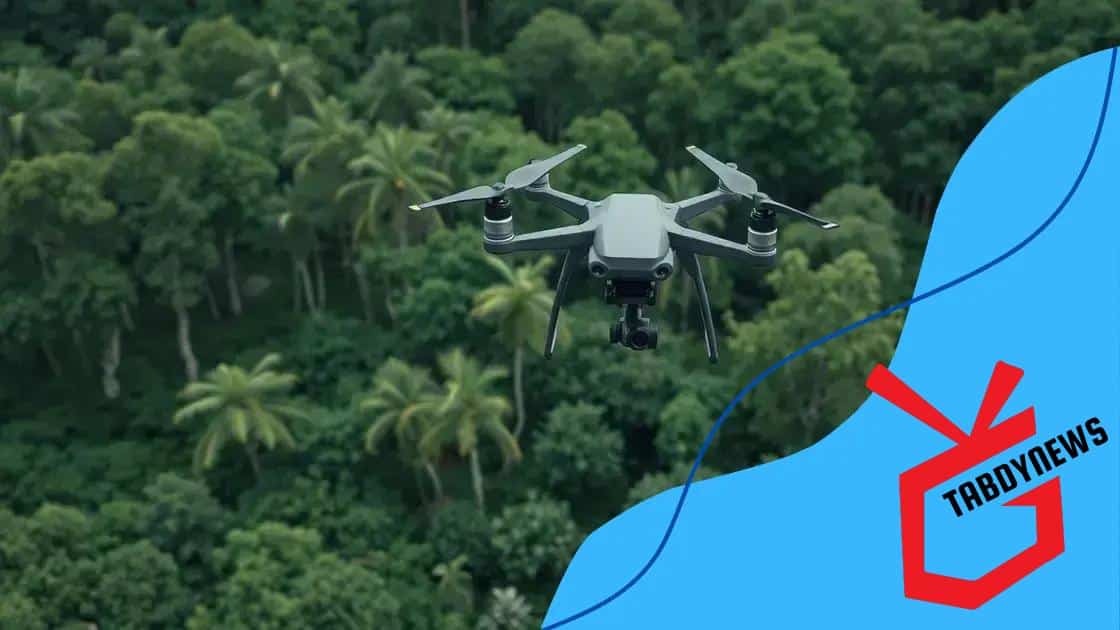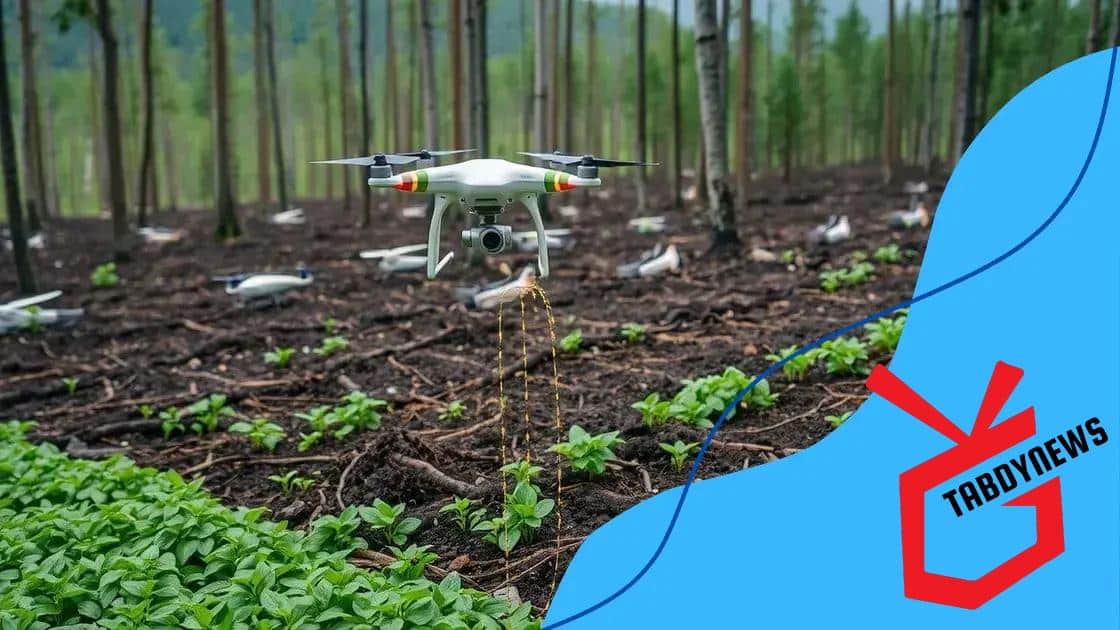Drone innovations for environmental conservation

Drones innovations for environmental conservation enhance wildlife monitoring, efficient data collection, and reforestation efforts, despite challenges like technical and regulatory issues.
Drone innovations for environmental conservation are changing the game in protecting our ecosystems. Have you considered how drones can help monitor wildlife and restore habitats? Let’s dive into this exciting topic.
Revolutionary uses of drones in conservation
Drones are transforming conservation efforts in surprising ways. These revolutionary tools are being used to monitor wildlife, track environmental changes, and support reforestation projects.
Wildlife Monitoring
Using drones for wildlife monitoring is one of the most significant advancements in conservation. They can fly over vast, hard-to-reach areas, capturing critical data without disturbing animals.
- Real-time data collection allows for faster response to threats.
- Drones can monitor population sizes and movements.
- They help prevent poaching by surveying protected areas.
By employing drone technology, conservationists can gain insights that were previously challenging to obtain. This capability enables better planning and management of wildlife reserves.
Habitat Mapping
Another remarkable application of drones is habitat mapping. Drones equipped with high-resolution cameras can create detailed maps of ecosystems. This information is essential for conservationists to understand how habitats are changing.
For instance, drones can identify areas affected by climate change and assist in planning restoration efforts. The ability to gather precise data rapidly is enhancing conservation strategies globally.
Moreover, the current trends show that drone technology is rapidly advancing, with new tools becoming available for conservationists. As technology evolves, so do the applications of drones in supporting sustainable practices.
In summary, the revolutionary uses of drones in conservation pave the way for more effective monitoring and management of our precious ecosystems. The data collected not only aids in immediate conservation efforts but also helps shape long-term strategies for protecting nature.
Enhancing wildlife monitoring with drones
Drones are playing a vital role in enhancing wildlife monitoring. These devices can cover large areas quickly and gather important data while minimizing disturbance to animals.
Real-time Data Collection
With real-time monitoring capabilities, drones can provide immediate feedback on various wildlife populations. This means conservationists can identify changes in behavior or numbers swiftly.
- Drones capture images and videos of animals in their natural habitats.
- They help track migration patterns of different species.
- Data collected can be analyzed to assess ecosystem health.
In addition to monitoring wildlife, drones are essential in protecting endangered species. By identifying poaching activities and illegal logging, drones help safeguard vulnerable animals and their habitats.
Behavioral Studies
Another fascinating use of drones is in studying animal behavior. By observing animals from the air, researchers can gain insights without causing stress to the creatures.
For example, drones allow scientists to study nesting patterns of birds or the social dynamics of herds. This kind of unobtrusive observation can reveal critical information about how wildlife interacts with their environments.
The integration of drone technology into wildlife research not only improves monitoring efficiency but also aids in the development of effective conservation strategies. As drones become more advanced, their potential applications will expand further, leading to a deeper understanding of wildlife.
Drones in reforestation efforts

Drones are becoming an essential tool in reforestation efforts worldwide. With their ability to cover large areas efficiently, they help restore forests and ecosystems at an unprecedented scale.
Seed Planting
One innovative use of drones in reforestation is automated seed planting. Drones can shoot seed pods into the ground, allowing for faster and more efficient planting compared to traditional methods.
- Seed pods are designed to protect seeds from birds and insects.
- This method reaches areas that are difficult for humans to access.
- Drones can quickly distribute thousands of seeds in a single flight.
This technology means that reforestation can occur in remote and previously inaccessible areas. Additionally, it allows for the planting of diverse species, promoting healthier ecosystems.
Monitoring Growth
Drones also play a crucial role in monitoring the growth of newly planted trees. By capturing aerial images, conservationists can assess how well forests are recovering.
These images help identify areas that may need additional support or management. Regular drone flights provide data that can be analyzed to track the health of the forest.
As drone technology improves, the accuracy and capability of monitoring efforts will enhance further. This allows for more informed decisions regarding forest management and conservation strategies.
In summary, the integration of drones in reforestation is paving the way for innovative and effective restoration methods. Their ability to plant seeds and monitor growth is essential for revitalizing our planet’s forests.
Data collection and analysis using drone technology
Drone technology has revolutionized how data is collected and analyzed in various fields, especially in environmental conservation. Drones can gather vast amounts of data quickly and efficiently from hard-to-reach areas.
High-Resolution Imagery
One of the key benefits of using drones is their ability to capture high-resolution images. These images provide detailed information about landscapes, vegetation, and wildlife.
- Drones can fly at different altitudes to capture various perspectives.
- The images can be used to map ecosystems and monitor changes over time.
- Using infrared technology, drones can identify plant health and detect stress levels.
This data is invaluable for assessing the health of ecosystems and making informed decisions about conservation efforts.
Data Analysis Techniques
Once data is collected, it needs to be analyzed. Advanced software can process the images and data captured by drones, translating them into meaningful insights.
For example, software can generate 3D maps or models of habitats, helping researchers visualize changes and plan interventions effectively. Researchers can quickly identify trends and anomalies, leading to timely responses to environmental issues.
As drone technology continues to evolve, the precision and capabilities of data collection will improve, enabling more sophisticated analysis. This will enhance the understanding of ecological dynamics and aid in effective conservation strategies.
Challenges and future of drones in conservation
The use of drones in conservation is exciting, but it also comes with challenges that need to be addressed. Understanding these hurdles is crucial for the future of drone technology in protecting our environment.
Technical Limitations
One significant challenge is the technical limitations of drone technology. While drones have advanced rapidly, they still face restrictions in terms of battery life and payload capacity.
- Battery life can restrict the duration of flights and the area that can be covered.
- Heavy payloads may require specialized drones, which can be expensive.
- Weather conditions, such as strong winds or rain, can affect flight operations.
These limitations can hinder the efficiency and effectiveness of conservation efforts, making it essential to continue improving drone technology.
Regulatory Challenges
Another challenge involves navigating regulatory hurdles. Drone operations are subject to laws and regulations that vary by region, which can impact their use in conservation.
Many countries have strict airspace regulations, and obtaining permits can be time-consuming. Additionally, there are privacy considerations to account for, especially when monitoring wildlife in sensitive areas.
As the use of drones becomes more commonplace, advocacy for clearer regulations can help facilitate smoother operations in conservation activities.
Future Developments
Looking to the future, advancements in drone technology hold great promise for conservation efforts. Innovations, such as improved battery life, artificial intelligence, and enhanced sensors, are set to transform how drones are used in the field.
These developments will allow for better data collection, more precise monitoring, and the ability to cover larger areas more effectively. By addressing current challenges and leveraging technological advancements, the future of drones in conservation appears bright.
In conclusion, drones are transforming the way we approach environmental conservation. They provide innovative solutions like real-time monitoring, efficient data collection, and effective reforestation efforts. Despite some challenges, including technical limitations and regulatory issues, the future of drone technology looks promising. By improving these tools and addressing current obstacles, we can harness their full potential to protect our planet and its wildlife.
\n
\n
FAQ – Frequently Asked Questions about Drones in Conservation
What are the main benefits of using drones in conservation?
Drones provide real-time monitoring, efficient data collection, and facilitate reforestation efforts, allowing for better protection of wildlife and ecosystems.
What challenges do drones face in conservation efforts?
Drones encounter technical limitations like battery life and payload capacity, as well as regulatory hurdles related to airspace rules and privacy concerns.
How do drones contribute to wildlife monitoring?
Drones can quickly cover vast areas, providing detailed images and data for tracking wildlife populations and monitoring their health without disturbing them.
What does the future hold for drone technology in conservation?
Future advancements may include better battery life, improved sensors, and AI integration, enhancing the capabilities of drones for effective conservation strategies.





